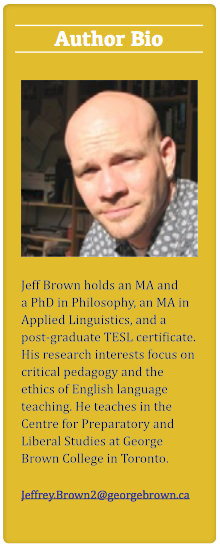Reflecting on the question of what recent findings or ideas ESL teaching might take from other fields, I suggest that recent insights on learning from the eld of cognitive psychology are worth exploring. Cognitive psychology is the study of the neural processes that underpin mental operations such as memory, attention, and creative problem-solving, among others. It is a broad, multi-disciplinary area of study, and its empirical findings have been drawn upon by a range of other fields. ESL teachers would do well to take notice of some of these findings.
My remarks here draw exclusively upon Brown, Roediger, and McDaniel’s (2014) fascinating book, Make it Stick: The Science of Successful Learning. I highly recommend it to anyone curious about the vast body of research in cognitive psychology. The central argument of the book, put simply, is that the most effective learning strategies are often counter-intuitive. Speci cally, there are three primary principles that ESL teachers should re ect upon and consider incorporating into their classroom practice (even if this means questioning or abandoning practices that we’ve come to take for granted).
1. Mix up your practice
There is probably nothing immediately counter-intuitive about this principal. Many ESL teachers already vary the activities they do in class, even more so if the class they are teaching is an integrated skills course. But it is still worth noting that the research shows that massed practice—the ‘practice-practice-practice’ mentality—is less effective than interleaved practice, which involves the interaction of more than one skill at a time. Perhaps most importantly, this suggests that retrieval/recall—and the utilization of a variety of approaches to achieve this—is more effective than review and rereading. So, completing a quiz, say, after a reading or listening is better than reviewing notes.
ESL teachers here might specifically apply this to the study of vocabulary. We have probably all seen students poring over a long list of vocabulary items, hoping that dogged repetition will anchor the words in their memory. However, a series of short quizzes focussing on retrieval rather than recognition would better strengthen the neural pathways that underpin retention. Presenting these quizzes as retrieval exercises, and explaining their purpose, can help students see the value in an alternative approach to vocabulary study and can also, as a fringe bene t, gradually alleviate the anxiety they feel when taking actual tests.
2. Embrace difficulties
The science clearly shows that learning that is effortful is stronger and more likely to be retained. Basically, if it’s difficult to learn, it’s more likely to stick. Struggling with a problem and eventually finding a solution is more conducive to learning than being provided with a formula or rule for finding the solution. A specific application of this principle for ESL teachers might be with respect to grammar instruction. It lends support to the effectiveness of an inductive method for grammar instruction as opposed to a deductive approach. At the very least it suggests that—at least occasionally—it might be preferable to let students struggle to identify grammar structures through context rather than provide them with a formal rule from the outset.
More generally, this principle of learning might be a welcome balance to the tendency in ESL teaching to make all our activities entertaining. This is understandable. Being told that your class is fun or enjoyable is often more affirming than being told that it is difficult or challenging. However, given that learning is an often laborious (at least) three-step process involving information encoding, consolidation, and retrieval, it only stands to reason that some classroom activities will indeed make students feel like they are working. While some teachers might already tacitly subscribe to this view, it’s vindicating to have the science to back it up.
3. Leave behind the learning-styles model
We are all familiar with the learning-styles model: some people are  visual learners, some are tactile learners, and some are auditory learners. However, the idea that a person learns more effectively when they are taught in a manner that conforms more to their preferred learning style is simply not supported by the science. Given these findings, learners are advised to resist settling into a comfortable niche or preferred learning style—to avoid complacency and the appeal of the familiar or of what “feels best”.
visual learners, some are tactile learners, and some are auditory learners. However, the idea that a person learns more effectively when they are taught in a manner that conforms more to their preferred learning style is simply not supported by the science. Given these findings, learners are advised to resist settling into a comfortable niche or preferred learning style—to avoid complacency and the appeal of the familiar or of what “feels best”.
It falls to us as teachers, then, to foster this approach in our classrooms and in our lessons. It’s also clear how this third principle is implicated with the rst two. Not catering to the preferred or perceived learning styles of our students entails embracing difficulties and, by definition, mixing up the practice in which we ask our learners to engage. This may often involve coaxing learners out of their default comfort zones, which in turn might mean moving beyond our comfort zones as teachers.
Clearly, there is a limit to this principle—and to the application of the other principles highlighted here. Varied activities can only be interleaved to the extent that the learning outcomes of a given class are supported; material should not be so difficult that it leaves students discouraged; and pushing students too far beyond their comfort zones is obviously counterproductive. Being a reflective and responsible practitioner means incorporating these insights into one’s teaching while being aware of such parameters.
References
Brown, P.C., Roediger, H. L. and McDaniel, M. A. (2014). Make it stick: The science of successful learning. Cambridge: Belknap-Harvard University Press.
